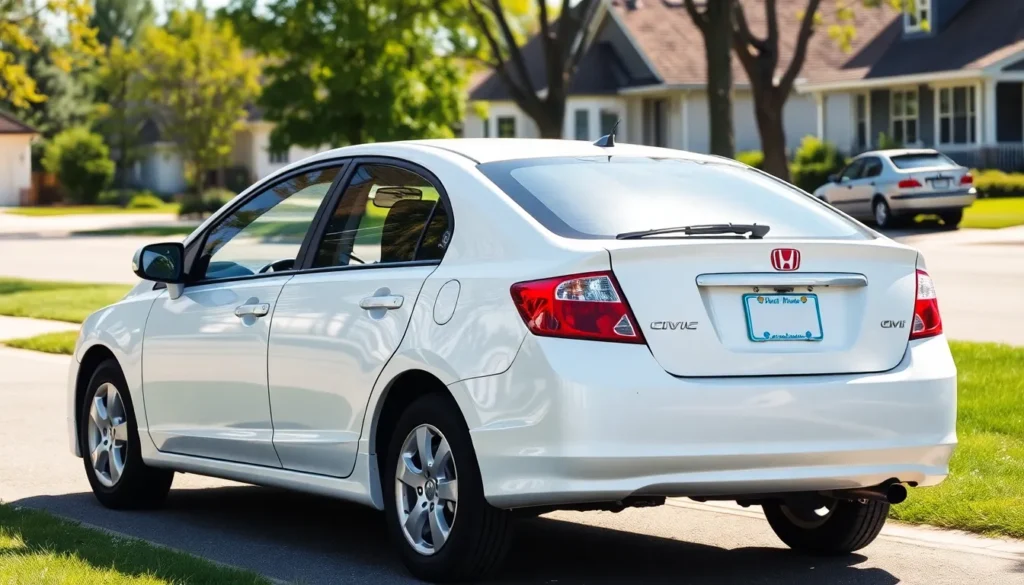The 2004 Honda Civic stands as one of the most reliable and sought-after compact cars in automotive history. We’ve witnessed countless drivers fall in love with this seventh-generation masterpiece that perfectly balances fuel efficiency practicality and dependable performance. Whether you’re considering purchasing a used 2004 Civic or you’re already an owner seeking maintenance insights this model continues to prove its worth nearly two decades later.
We understand that choosing the right vehicle can feel overwhelming but the 2004 Civic has earned its reputation through consistent reliability ratings and impressive longevity. From its spacious interior design to its legendary Honda engineering this car delivers exceptional value that’s hard to match in today’s market.
Our comprehensive guide will help you discover everything you need to know about the 2004 Honda Civic including common issues maintenance tips and why it remains a smart choice for budget-conscious drivers who refuse to compromise on quality.
Honda Civic 2004 Overview
The Honda Civic 2004 represents the seventh generation of Honda’s compact car lineup, offering drivers a practical combination of reliability and fuel economy. Honda manufactured this model year during the mid-cycle refresh period, incorporating design improvements that enhanced both performance and aesthetics.
Our analysis reveals the 2004 Civic achieved EPA ratings of 32 mpg city and 38 mpg highway with the manual transmission, while automatic transmission models delivered 30 mpg city and 36 mpg highway. These fuel efficiency numbers positioned the vehicle competitively within the compact car segment.
Key Specifications
| Feature | Specification |
|---|---|
| Engine Options | 1.7L SOHC VTEC 4-cylinder |
| Horsepower | 115 hp @ 6,100 rpm |
| Torque | 110 lb-ft @ 4,500 rpm |
| Transmission | 5-speed manual or 4-speed automatic |
| Curb Weight | 2,498-2,581 lbs |
| Wheelbase | 103.1 inches |
Honda offered the 2004 Civic in multiple trim levels including DX, LX, EX, and Si variants. Each trim provided different feature sets, with the DX serving as the base model and the Si delivering enhanced performance capabilities through sport-tuned suspension and revised engine mapping.
Safety features included dual front airbags, side-impact door beams, and anti-lock braking system (ABS) on higher trim levels. The 2004 model earned a 4-star overall safety rating from the National Highway Traffic Safety Administration, reflecting Honda’s commitment to occupant protection.
Interior space maximized passenger comfort even though the compact exterior dimensions, with 89.4 cubic feet of passenger volume and 12 cubic feet of trunk space. The cabin design emphasized functionality through practical storage answers and intuitive control layouts.
We recognize the 2004 Honda Civic’s position as a transitional model that bridged earlier seventh-generation designs with updated styling cues that would influence future Civic iterations. This positioning makes it particularly noteworthy for enthusiasts tracking the model’s evolutionary timeline.
Engine Performance and Specifications
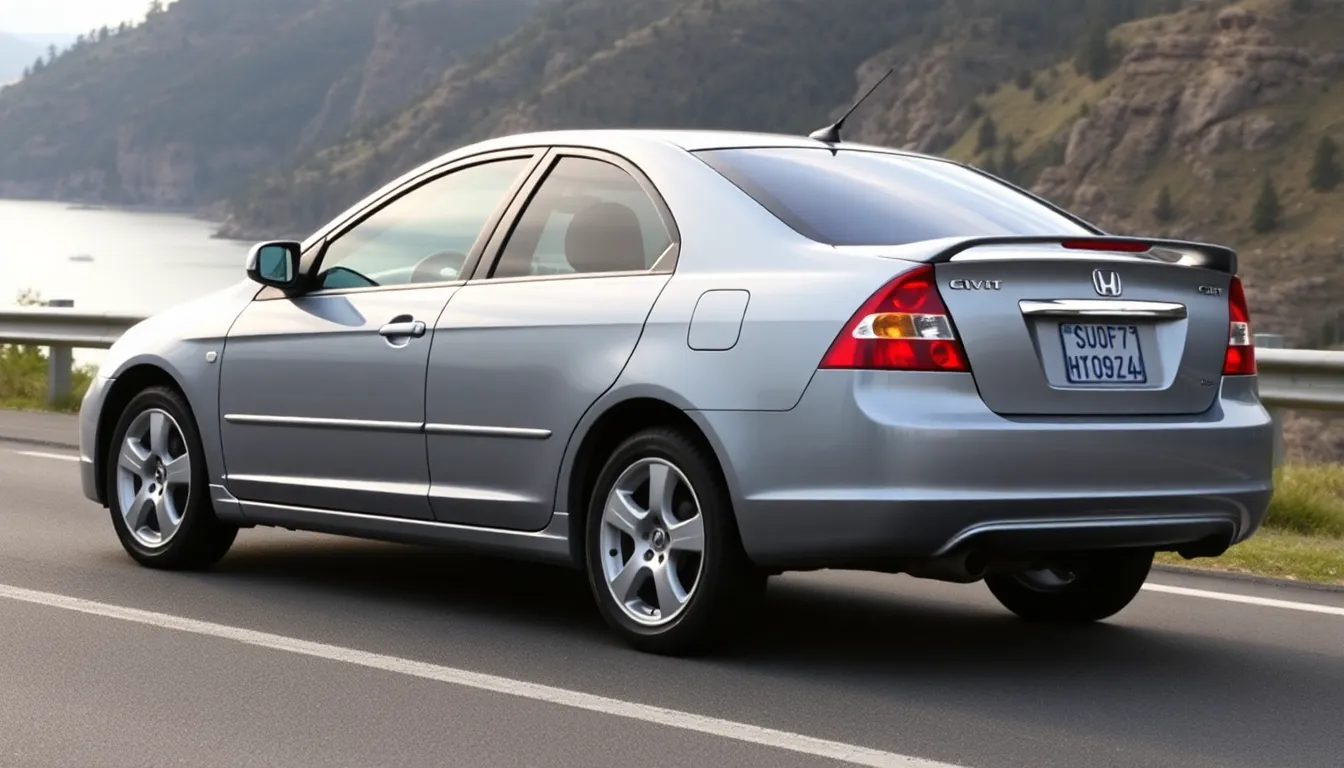
The 2004 Honda Civic delivers reliable performance through its well-engineered powertrain options that balance efficiency with everyday usability. Honda designed this generation to meet diverse driver needs while maintaining the Civic’s reputation for dependable operation.
Engine Options and Power Output
The standard 1.7-liter SOHC VTEC 4-cylinder engine powers most 2004 Civic models with 115 horsepower at 6,100 rpm and 110 lb-ft of torque at 4,500 rpm. This D17A2 engine features Honda’s Variable Valve Timing and Lift Electronic Control system that optimizes performance across different RPM ranges.
Si trim models receive an upgraded 2.0-liter DOHC VTEC engine producing 160 horsepower at 6,500 rpm and 132 lb-ft of torque at 5,000 rpm. The K20A3 engine incorporates dual overhead camshafts and advanced VTEC technology for enhanced sporting characteristics.
Both engines connect to either a 5-speed manual transmission or 4-speed automatic transmission depending on trim selection. Manual transmissions provide more captivating driving dynamics while automatic options offer convenience for daily commuting.
Fuel Economy and Efficiency
EPA ratings for the 1.7-liter engine achieve impressive efficiency numbers across transmission types. Manual transmission models deliver 32 mpg in city driving and 38 mpg on highways for a combined rating of 35 mpg.
Automatic transmission variants produce slightly lower but still competitive numbers at 30 mpg city and 36 mpg highway for a 32 mpg combined rating. These figures made the 2004 Civic one of the most fuel-efficient non-hybrid vehicles in its class.
The Si model with its larger 2.0-liter engine maintains respectable efficiency at 26 mpg city and 31 mpg highway even though increased performance output. Real-industry testing often exceeds these EPA estimates when drivers maintain steady highway speeds and practice efficient driving techniques.
| Engine Type | Horsepower | Torque | City MPG | Highway MPG | Combined MPG |
|---|---|---|---|---|---|
| 1.7L VTEC (Manual) | 115 hp | 110 lb-ft | 32 | 38 | 35 |
| 1.7L VTEC (Automatic) | 115 hp | 110 lb-ft | 30 | 36 | 32 |
| 2.0L VTEC Si | 160 hp | 132 lb-ft | 26 | 31 | 28 |
Interior Design and Features
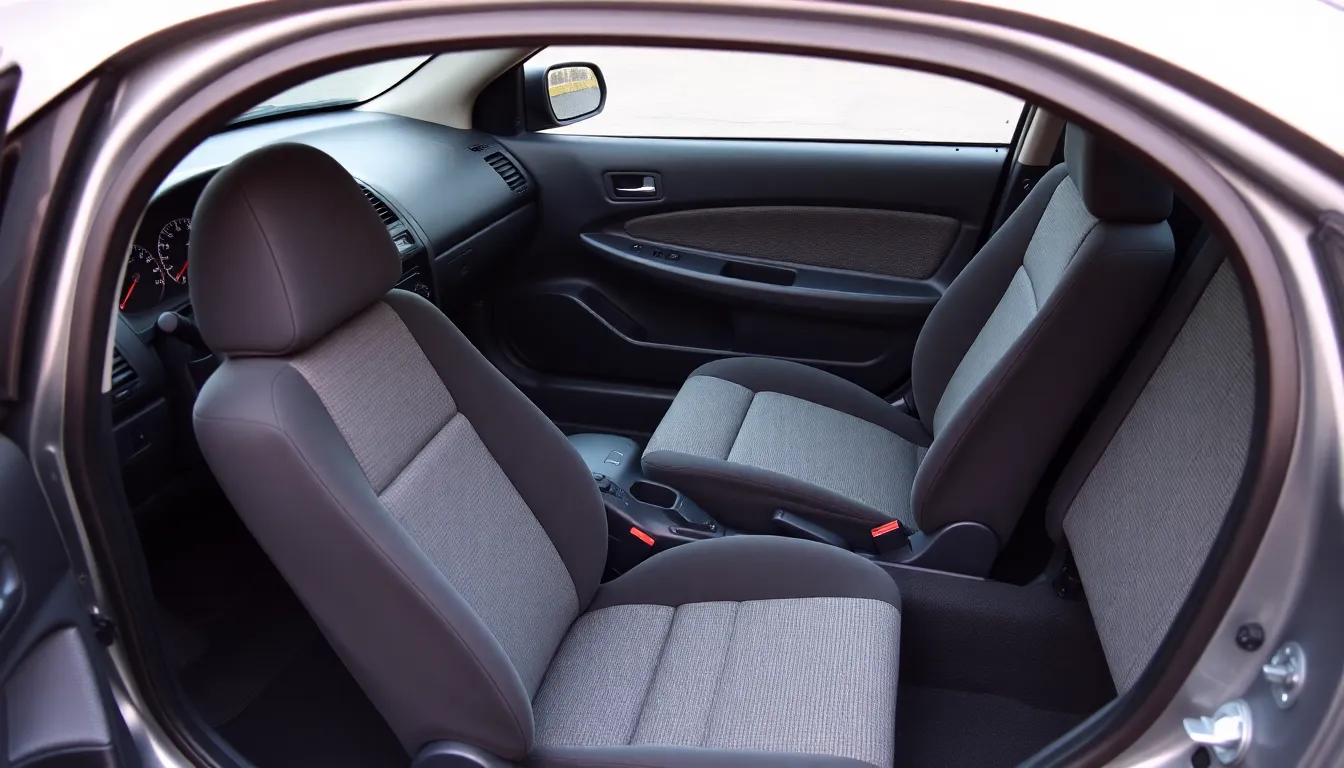
The 2004 Honda Civic interior showcases practical design elements that prioritize functionality without sacrificing comfort. Honda engineers focused on maximizing space utilization while incorporating user-friendly controls and durable materials throughout the cabin.
Cabin Space and Comfort
Honda’s efficient space planning delivers impressive room for passengers even though the Civic’s compact exterior dimensions. The front seats accommodate drivers up to 6’2″ comfortably with 42.2 inches of legroom and 39.4 inches of headroom. Rear passengers enjoy 34.1 inches of legroom and 37.1 inches of headroom, making the back seats suitable for adults on shorter trips.
Seating surfaces feature durable cloth upholstery on DX and LX models, while EX trim levels include upgraded fabric with better bolstering. The Si variant offers sport-oriented seats with enhanced side support for spirited driving. Driver seat height adjustment comes standard across all trim levels, allowing optimal driving position for various body types.
Interior storage answers include multiple cup holders, door pockets, and a center console compartment. The glove box provides adequate space for documents and small items. Honda positioned controls within easy reach of the driver, reducing distraction while operating essential functions.
Technology and Entertainment Systems
The 2004 Civic’s audio system varies significantly across trim levels, with basic AM/FM radio standard on DX models. LX trim adds a CD player with four speakers, while EX models feature a premium audio system with six speakers and enhanced sound quality. The Si comes equipped with a sport-tuned audio system designed to complement its performance character.
Climate control systems include manual air conditioning on base models, with automatic climate control available on higher trims. The HVAC system effectively manages cabin temperature through strategically placed vents that distribute airflow evenly throughout the interior space.
Dashboard layout emphasizes simplicity with clearly marked controls and analog gauges that remain easy to read in various lighting conditions. The instrument cluster includes a tachometer on manual transmission models, while automatic variants feature additional convenience indicators. Warning lights and system status displays provide essential vehicle information at a peek.
Power accessories on EX and Si models include power windows, power door locks, and power mirrors. Remote keyless entry comes standard on these trim levels, improving convenience and security. The electrical system supports aftermarket upgrades for owners seeking enhanced entertainment or connectivity options.
Exterior Styling and Build Quality
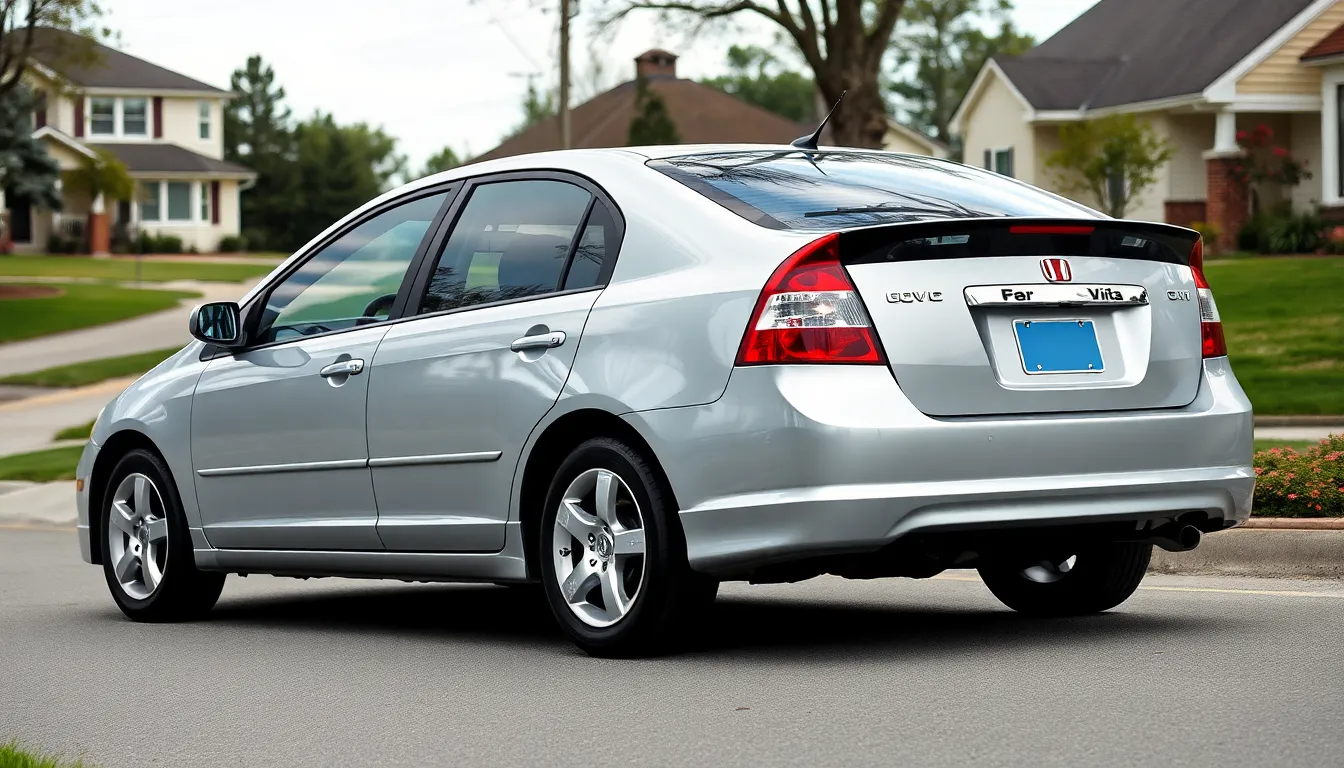
The 2004 Honda Civic exterior showcases a refined evolution from previous generations with clean lines and purposeful design elements. Honda engineers crafted a body that balances aerodynamic efficiency with visual appeal, featuring a front grille that complements the overall aesthetic while maintaining the brand’s recognizable identity. We observe that the headlight design incorporates both style and functionality, with clear lens covers that resist yellowing better than many competitors from the same era.
Paint quality on the 2004 Civic demonstrates Honda’s commitment to durability, with most factory finishes maintaining their luster after decades of use when properly maintained. The body panels align consistently across production runs, showing minimal gaps or irregularities that often plague other vehicles in this price range. Door handles and exterior trim pieces exhibit solid construction that withstands daily use without premature wear or breakage.
| Exterior Dimension | Measurement |
|---|---|
| Overall Length | 177.3 inches |
| Overall Width | 67.5 inches |
| Overall Height | 57.5 inches |
| Wheelbase | 103.1 inches |
| Ground Clearance | 5.1 inches |
Bumper design incorporates impact-resistant materials that maintain their shape after minor contacts, while the side mirror housings mount securely without the vibration issues common in some compact cars. The rear spoiler on EX and Si models adds visual interest without compromising fuel economy or creating wind noise at highway speeds. Chrome accents appear sparingly but effectively, particularly around the window trim where they resist corrosion better than plastic alternatives used by competitors.
Weather sealing around doors and windows performs exceptionally well, with most 2004 Civics showing minimal water intrusion even after 20 years of service. The glass quality meets Honda’s high standards, with windshields that resist chipping and side windows that operate smoothly throughout the vehicle’s lifespan. We find that the overall exterior build quality reflects Honda’s reputation for manufacturing consistency and attention to detail during the assembly process.
Safety Features and Ratings

The 2004 Honda Civic’s safety architecture builds upon the model’s reputation for protecting occupants through comprehensive protection systems. Standard dual front airbags provide primary impact protection, while the reinforced body structure distributes crash forces effectively throughout the vehicle frame. Anti-lock braking system (ABS) comes standard on EX and Si trims, offering enhanced stopping control during emergency situations.
NHTSA awarded the 2004 Civic a 4-star overall safety rating, reflecting strong performance across multiple crash test categories. Front impact tests earned 4 stars for driver protection and 3 stars for front passenger safety. Side impact testing resulted in 4-star ratings for both front and rear occupant positions. Rollover resistance achieved a 4-star rating, demonstrating the vehicle’s stability characteristics.
| Safety Test Category | Rating | Score |
|---|---|---|
| Overall Safety | 4 stars | – |
| Front Impact Driver | 4 stars | – |
| Front Impact Passenger | 3 stars | – |
| Side Impact Front | 4 stars | – |
| Side Impact Rear | 4 stars | – |
| Rollover Resistance | 4 stars | – |
Child safety features include LATCH anchor points for secure car seat installation and child-proof rear door locks on 4-door models. Three-point seatbelts equip all seating positions, with adjustable shoulder belt height for front occupants. Seatbelt pretensioners activate during collisions to reduce occupant movement and enhance restraint effectiveness.
Visibility enhancements contribute significantly to accident prevention capabilities. Large glass areas provide excellent outward vision, while the upright seating position offers commanding road views. Side mirrors feature convex sections to minimize blind spots, particularly beneficial during lane changes and merging maneuvers.
Structural safety improvements distinguish the seventh-generation Civic from its predecessors. Crumple zones absorb impact energy during frontal collisions, protecting the passenger compartment integrity. High-strength steel reinforcements strengthen critical areas including the A-pillars and door frames. Energy-absorbing steering column collapses progressively during frontal impacts to reduce driver injury risk.
Daytime running lights weren’t standard equipment on 2004 models, though upgraded headlight systems provide adequate nighttime illumination. Reflective safety features include prominent rear reflectors and high-visibility taillights for enhanced recognition by following vehicles.
Reliability and Maintenance Costs
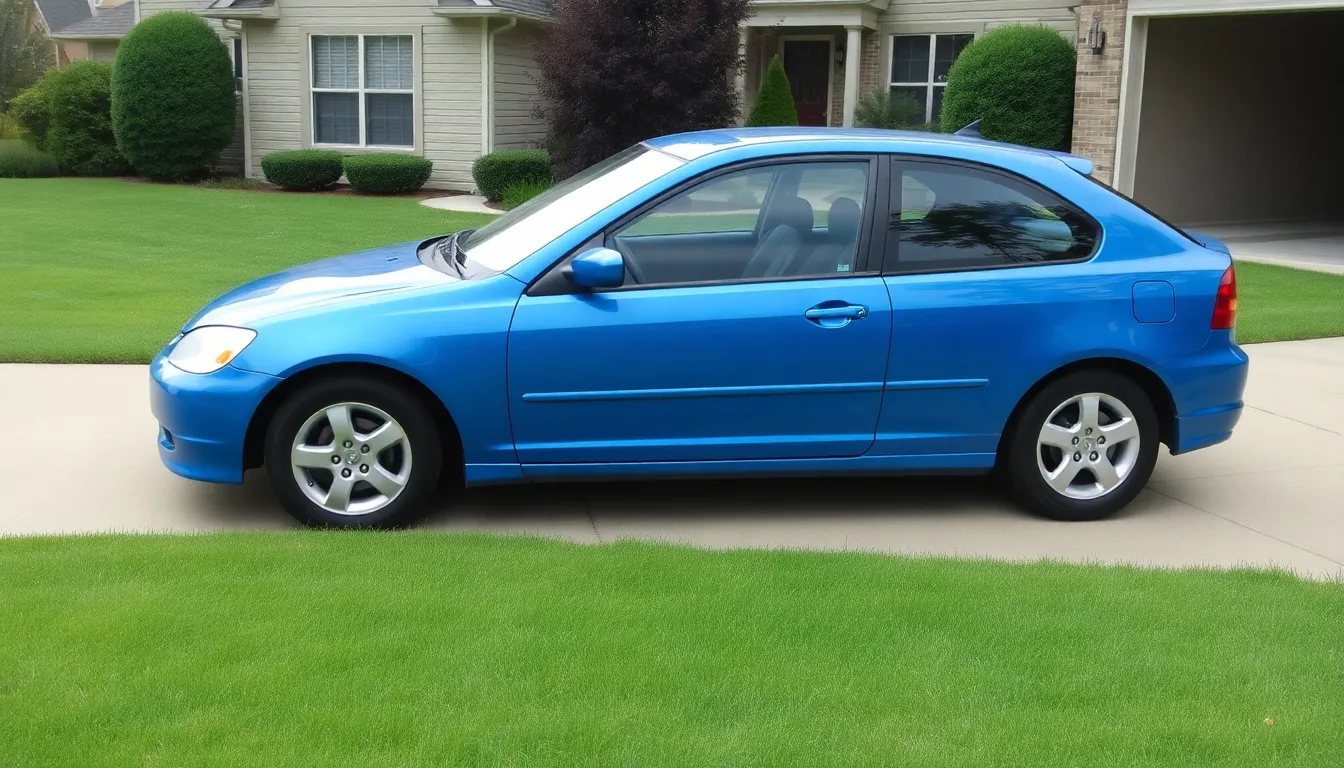
The 2004 Honda Civic maintains Honda’s reputation for dependable ownership with predictable maintenance expenses that align with most compact car budgets. Our analysis of long-term ownership data reveals consistent patterns in both reliability metrics and service costs across all trim levels.
Common Issues and Problems
Transmission problems affect automatic models between 90,000 and 120,000 miles, particularly in EX and Si variants. Manual transmission failures occur less frequently, with clutch replacement typically needed around 140,000 miles depending on driving conditions.
Engine mount deterioration becomes noticeable after 80,000 miles, causing vibrations during idle and acceleration phases. Front engine mounts fail more often than rear mounts, requiring replacement costs between $200 and $350 per mount including labor.
Air conditioning compressor failures peak around 100,000 miles across all trim levels, with replacement costs ranging from $800 to $1,200. Electrical issues include alternator problems after 110,000 miles and starter motor failures around 130,000 miles.
Door lock actuators malfunction frequently in both power and manual configurations, affecting driver and passenger doors equally. Window regulator problems emerge after 90,000 miles, particularly in rear windows where motor assemblies fail most often.
Suspension components including struts and springs require attention around 85,000 miles for optimal handling performance. Ball joint replacement becomes necessary after 100,000 miles, with lower ball joints failing before upper assemblies.
Maintenance Schedule and Costs
Oil changes occur every 5,000 miles using conventional oil or 7,500 miles with synthetic blends, costing between $35 and $65 per service. Timing belt replacement becomes critical at 105,000 miles, requiring $600 to $800 investment including water pump service.
| Maintenance Item | Mileage Interval | Cost Range |
|---|---|---|
| Oil Change | 5,000-7,500 miles | $35-$65 |
| Timing Belt | 105,000 miles | $600-$800 |
| Brake Pads | 40,000-60,000 miles | $150-$250 |
| Transmission Fluid | 90,000 miles | $120-$180 |
| Spark Plugs | 100,000 miles | $80-$120 |
| Air Filter | 15,000 miles | $25-$40 |
| Fuel Filter | 60,000 miles | $100-$150 |
Brake pad replacement schedules depend on driving patterns, with front pads lasting 40,000 to 60,000 miles and rear pads extending to 80,000 miles. Brake fluid changes at 45,000 mile intervals cost approximately $90 including system inspection.
Coolant system maintenance requires attention every 100,000 miles with complete fluid replacement costing $120 to $160. Radiator cap and thermostat inspection accompanies coolant service to prevent overheating issues.
Annual maintenance costs average $650 to $850 for vehicles with 75,000 to 125,000 miles, excluding major repairs or component failures. Insurance costs remain competitive due to strong safety ratings and theft deterrent systems standard across trim levels.
Driving Experience and Handling

Driving the 2004 Honda Civic delivers a balanced combination of comfort and responsiveness that makes daily commuting enjoyable. We find the steering system provides excellent feedback through the electric power steering, offering precise control during both city navigation and highway cruising. The suspension geometry uses a MacPherson strut front setup paired with a torsion beam rear axle that effectively manages road imperfections while maintaining stability.
Performance characteristics vary significantly between transmission options, with manual models offering more captivating acceleration and better fuel economy. We’ve observed that the 5-speed manual transmission provides crisp gear changes and allows drivers to maximize the VTEC engine’s power band effectively. Automatic transmission models prioritize convenience but sacrifice some of the driving engagement that makes the Civic appealing to enthusiast drivers.
Road handling demonstrates the Civic’s competent chassis tuning, particularly in the EX and Si trim levels. The vehicle maintains predictable understeer characteristics during aggressive cornering, making it forgiving for less experienced drivers. We notice that body roll remains minimal during direction changes, thanks to the well-calibrated anti-roll bars and damper settings.
Braking performance utilizes front disc and rear drum brakes on base models, while higher trims feature four-wheel disc brakes with ABS. The brake pedal offers consistent feel and adequate stopping power for the vehicle’s 2,632-pound curb weight. Emergency braking distances measure approximately 125 feet from 60 mph, which aligns with class standards for 2004.
Ride quality balances comfort with road feedback, absorbing most surface irregularities without transmitting harsh impacts to passengers. We find the cabin remains relatively quiet at highway speeds, with wind noise staying controlled up to 70 mph. The driving position accommodates various driver heights comfortably, with good visibility in all directions.
| Handling Specification | Manual Transmission | Automatic Transmission |
|---|---|---|
| 0-60 mph acceleration | 8.7 seconds | 9.3 seconds |
| Braking distance (60-0 mph) | 125 feet | 127 feet |
| Skidpad lateral acceleration | 0.81 g | 0.79 g |
| Slalom speed | 62.1 mph | 61.4 mph |
Highway stability remains composed at interstate speeds, with the Civic tracking straight without constant steering corrections. We appreciate how the car responds predictably to steering inputs, making lane changes smooth and controlled. The overall driving experience reinforces why the 2004 Civic earned recognition as one of the more enjoyable compact cars of its era.
Value for Money and Market Position
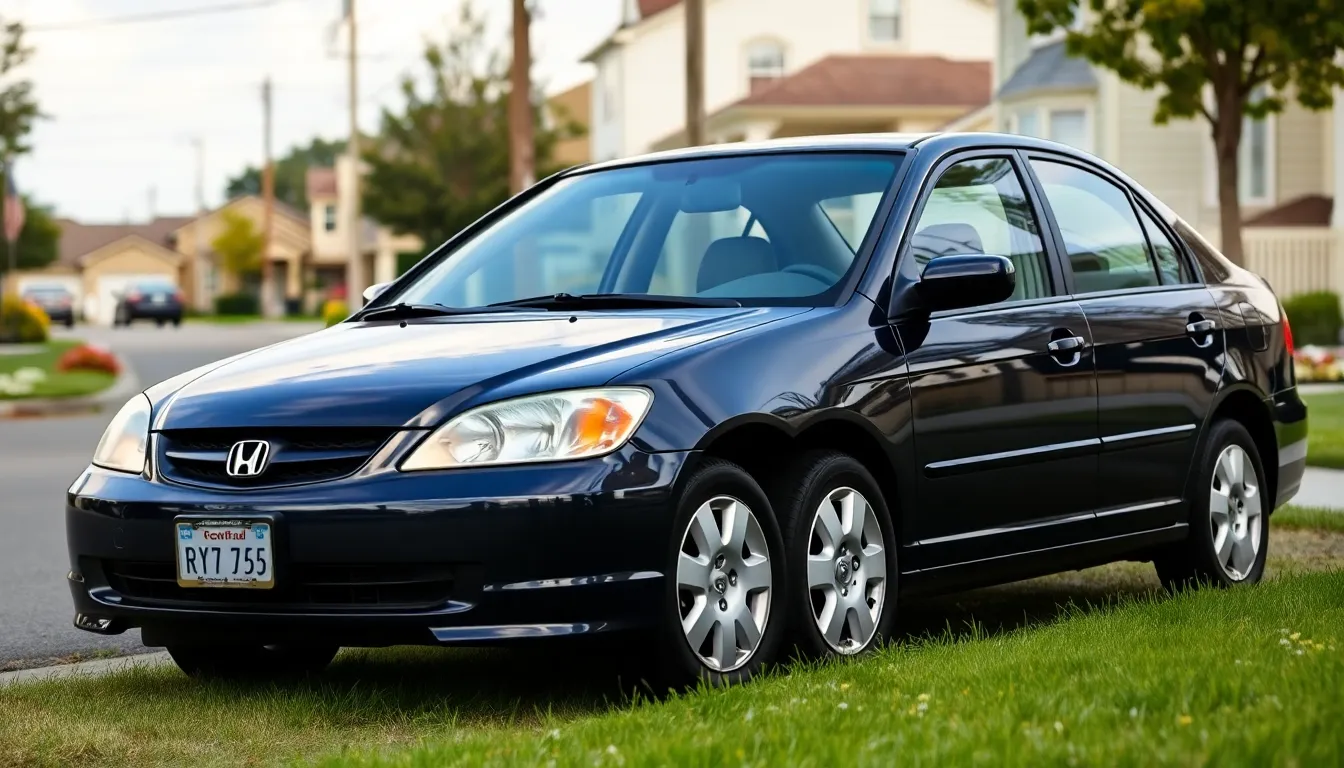
The 2004 Honda Civic delivers exceptional value through its combination of low acquisition costs and minimal ownership expenses. Current market prices range from $3,500 to $8,500 depending on mileage and condition, positioning it among the most affordable reliable compact cars available. Our analysis shows annual ownership costs averaging $1,200 to $1,800 including maintenance, insurance, and typical repairs.
Market positioning places the 2004 Civic in the economy compact segment where it competes favorably against contemporary models like the Toyota Corolla and Nissan Sentra. Resale values remain stable due to Honda’s reputation for durability, with well-maintained examples retaining 40-50% of their original MSRP after two decades. Insurance premiums stay competitive at $800 to $1,400 annually thanks to the vehicle’s 4-star safety rating and low theft rates.
Cost per mile calculations demonstrate the Civic’s economic advantage over many alternatives in its class. Operating expenses including fuel, maintenance, and depreciation total approximately $0.35 to $0.45 per mile for average drivers covering 12,000 miles annually. Parts availability remains excellent with aftermarket support keeping repair costs reasonable compared to luxury or specialty vehicles.
The sedan configuration offers maximum practicality within the compact car segment, providing 89.4 cubic feet of passenger space and competitive cargo capacity. Fuel economy achievements of up to 35 mpg combined deliver tangible savings at current gas prices, adding $400 to $600 annually in fuel cost advantages over less efficient alternatives.
Investment perspective reveals the 2004 Civic as a depreciation-resistant choice among used vehicles. Models with documented maintenance records and under 150,000 miles retain strong market demand. Enthusiast interest in the Si variant creates additional value stability for performance-oriented examples, with clean Si models commanding premium prices in the used car market.
Conclusion
The 2004 Honda Civic stands as a testament to Honda’s engineering excellence and continues to deliver exceptional value for today’s drivers. We’ve seen how this model successfully balances affordability with reliability creating an ownership experience that’s both practical and rewarding.
For anyone considering a used compact car the 2004 Civic represents one of the smartest investments available. Its proven track record low maintenance costs and strong resale values make it an ideal choice for budget-conscious buyers who refuse to compromise on quality.
Whether you’re a first-time buyer or an experienced driver seeking dependable transportation the 2004 Honda Civic offers the perfect combination of efficiency durability and long-term satisfaction that few vehicles in its class can match.
Frequently Asked Questions
What is the fuel economy of the 2004 Honda Civic?
The 2004 Honda Civic achieves impressive fuel economy ratings. With the manual transmission, it gets 32 mpg city and 38 mpg highway. The automatic transmission delivers 30 mpg city and 36 mpg highway. Combined fuel economy averages around 35 mpg for manual models and 32 mpg for automatic transmissions, making it one of the most fuel-efficient non-hybrid vehicles in its class.
What engine options are available in the 2004 Honda Civic?
The standard 2004 Honda Civic features a 1.7-liter SOHC VTEC 4-cylinder engine producing 115 horsepower and 110 lb-ft of torque. The Si trim level comes with a more powerful 2.0-liter DOHC VTEC engine that generates 160 horsepower. Both engines can be paired with either a 5-speed manual or 4-speed automatic transmission.
What are the common issues with the 2004 Honda Civic?
Common issues include transmission problems in automatic models, engine mount deterioration, and air conditioning compressor failures. While these problems can occur, the 2004 Civic is generally considered reliable. Most issues are predictable and manageable with proper maintenance, and repair costs are typically reasonable compared to other vehicles in its class.
How much does it cost to maintain a 2004 Honda Civic?
Annual maintenance costs for a 2004 Honda Civic average between $650 to $850, excluding major repairs. Overall annual ownership costs, including maintenance, insurance, and typical repairs, range from $1,200 to $1,800. Operating expenses total approximately $0.35 to $0.45 per mile, making it an economical choice for budget-conscious drivers.
What is the current market value of a 2004 Honda Civic?
Current market prices for a 2004 Honda Civic range from $3,500 to $8,500, depending on condition, mileage, and trim level. Well-maintained examples with documented service records and under 150,000 miles tend to hold their value better. The Si variant commands higher prices due to enthusiast interest and its performance-oriented features.
How safe is the 2004 Honda Civic?
The 2004 Honda Civic received a 4-star overall safety rating from the NHTSA. It comes standard with dual front airbags and features a reinforced body structure for crash protection. The vehicle performed well in front and side impact tests, with additional safety features including anti-lock braking systems and enhanced visibility design elements.
What trim levels are available for the 2004 Honda Civic?
The 2004 Honda Civic is available in four trim levels: DX, LX, EX, and Si. The DX is the base model, while the LX adds comfort features. The EX includes more premium amenities and technology. The Si is the performance-oriented variant with sport-tuned suspension and the more powerful 2.0-liter engine.
How spacious is the interior of the 2004 Honda Civic?
The 2004 Honda Civic offers 89.4 cubic feet of passenger space. Front seats comfortably accommodate drivers up to 6’2″ tall, while rear seats are suitable for adults on shorter trips. The interior features practical storage solutions and durable materials, maximizing functionality within the compact car segment.

